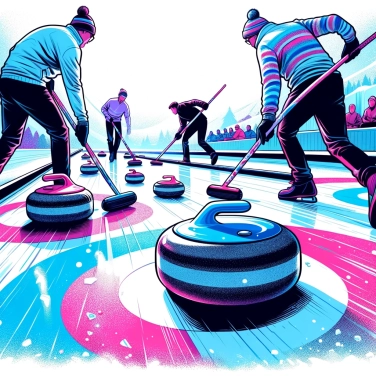Curling uses ice because the low friction allows the stones to slide more easily and in a controlled manner on the surface, making the game easier.

Ice is an ideal surface for curling because it possesses a key property: a subtle mix of slip and grip. Upon contact, the granite stone hardly rubs against it, as friction is minimized thanks to a thin layer of liquid water that naturally forms under pressure and friction. This phenomenon is called pressure melting: when the stone slides, its own weight and the slight warming caused by friction turn a thin layer of ice into liquid, making the surface very slippery. It's like a tiny cushion of water that allows the stone to travel far and accurately. At the same time, the small roughness on the surface of the ice (intentionally prepared by curling specialists) prevents uncontrolled sliding, giving players precise control over the trajectory.
Ice, especially when prepared for curling, forms a thin layer of liquid water under the sliding stones. This small film of water acts as a natural lubricant by drastically reducing friction. As a result, the stone travels further and in a much more fluid and predictable manner. The less friction there is, the easier it is to control the precise trajectory of the throw and execute subtle effects (or "curl") that make all the difference in the game. Without this phenomenon of reduced friction induced by the ice, the stones would slow down too quickly and would be nearly impossible to guide accurately over long distances.
The quality of the ice surface plays a major role in curling. Generally, before the game, the ice undergoes a process called pebbling: fine droplets of water are sprayed onto it, which freeze quickly to create many small bumps on the surface. These mini-bumps further reduce friction and allow the stone to slide better and further. The ideal temperature of the ice is just a little below zero, often around -5°C to -7°C: if it is too cold, the ice would be brittle and crumbly, and if it is too warm, it would become wet and unnecessarily slow down the stones. The precise dosage of these parameters is essential to ensure the effectiveness of the game and allow curlers to make controlled and consistent throws.
By vigorously brushing the ice right in front of the stone, players generate a thin layer of liquid water, thereby reducing friction. This phenomenon allows the stone to slide longer and straighter, facilitating precise control of its trajectory. Enhanced brushing can easily extend the distance traveled, while more moderate pressure allows for subtle corrections. In short, brushing is like having a smooth accelerator pedal on the ice: the more you brush, the more your stone accelerates and stays true to your initial trajectory.
On concrete, wood, or plastic, friction is too strong or too irregular to achieve a smooth and precise trajectory for curling stones. These materials grip too much: the stone slows down quickly and loses all sliding accuracy. A surface like grass or soil? Too soft, it absorbs the energy of the throw and stops the stone directly. On the other hand, something smooth like metal or glass? Too smooth indeed: it's impossible to control the trajectory, the stone would go off in all directions without any control. Ice, on the other hand, offers the ideal balance between very light grip and sliding, thanks to its specific properties related to a thin layer of water created under the stone. That's why ice is essential for curling.
The surface of the curling ice is not perfectly smooth. It is covered with tiny frozen water droplets, called 'pebble', which further reduce friction and allow for very precise trajectories.
When they sweep the ice, the players slightly warm the surface, thereby further reducing the friction in front of the stone, which increases the distance it travels and slightly influences its trajectory.
A regulation curling stone weighs between 17 and 20 kg. This significant weight enhances its stability and makes its trajectory more predictable despite the sweeping actions on the ice.
Curling is nicknamed 'chess on ice' due to its numerous strategic aspects. Players must accurately anticipate how their stone will move on the ice in order to block their opponents or skillfully position their stone to score points.
The sweepers slightly heat the ice through friction, which causes the pebbles to melt slightly and further reduces friction, allowing for better control of the speed and trajectory of the stones.
Although some surfaces may seem slippery, none allow for the same level of precision and fine control as textured ice. The specific characteristics of reduced friction and controllability provided by ice cannot currently be achieved by any other conventional surface.
The optimal temperature of the ice for curling is around -4 to -6 degrees Celsius. This setting allows for a sturdy surface while remaining sufficiently slick and responsive to slight variations caused by sweeping.
Although technically possible, it is not recommended because the ice for hockey or figure skating has a flat and smooth surface, while curling requires specially textured ice ('pebbling') to ensure the proper movement of the stones.
The ice in curling is textured (called 'pebbling') to reduce the direct contact surface between the stone and the ice, thereby reducing friction and allowing the stones to slide and curl with better consistency and accuracy.

No one has answered this quiz yet, be the first!' :-)
Question 1/5